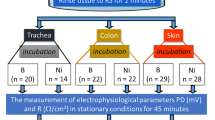Abstract
Sodium crosses epithelia in two steps: an influx into the cell through the luminal membrane down an electrochemical gradient, and an energy-requiring efflux across the serosal border against a gradient. Koefoed-Johnsen and Ussing1 originally proposed that cellular efflux of Na+ at the serosal border of frog skin is coupled to K+ influx by an exchange pump. It was, therefore, assumed that the inhibition of active Na+ transport following the removal of K+ from the serosal side was due to a reduced pool of K+ available for the coupled exchange. Indirect evidence suggests that this is not correct. (1) K+ influx from the serosa does not correlate to any significant degree with active Na+ transport2–5. (2) Removal of Na+ as well as K+ from the serosal medium substantially reduces the inhibitory effect of K+ removal on active transport2,6. (3) One would predict that if K+ removal did inhibit active transport only at the serosal pump site, then as active transport decreased the ‘active transport pool’, that is, the mucosally derived cell Na+, would increase as it does with ouabain. Studies by Robinson and Macknight7, however, showed that the mucosally derived pool does not change on removal of external K+. Essig and Leaf2 suggested that removal of serosal K+ inhibited Na+ transport by decreasing the permeability of the luminal membrane. They showed that when K+ was removed from the serosa, there was a decrease in the amount of 22Na taken up into the tissue after exposure of the luminal surface to the isotope for 5 min. We have recently found that tissue uptake of 22Na after exposure of toad bladders to the isotope is linear with time for only up to 24 s. Because only the linear portion of the uptake is a measure of the Na+ flux across the luminal border8, it is clear that longer periods of uptake are more representative of the steady-state isotope distribution in the tissue. This value is controlled not only by the luminal permeability but also by the serosal permeability and the rate of net transport. These issues prompted us to re-investigate the effect of low external K+ on Na+ movement across the luminal border. We report here that the Na+ transport inhibition seems to be due to a reduced Na+ permeability at the luminal border.
This is a preview of subscription content, access via your institution
Access options
Subscribe to this journal
Receive 51 print issues and online access
$199.00 per year
only $3.90 per issue
Buy this article
- Purchase on Springer Link
- Instant access to full article PDF
Prices may be subject to local taxes which are calculated during checkout
Similar content being viewed by others
References
Koefoed-Johnsen, V. & Ussing, H. H. Acta physiol. scand. 42, 298–308 (1958).
Essig, A. & Leaf, A. J. gen. Physiol. 46, 505–515 (1963).
Nellans, H. N. & Schultz, S. G. J. gen. Physiol. 68, 441–463 (1976).
Robinson, B. A. & Macknight, A. D. C. J. Membrane Biol. 26, 269–296 (1976).
DeLong, J. & Civan, M. M. J. Membrane Biol. 42, 19–43 (1978).
Essig, A. Am. J. Physiol. 208, 401–406 (1965).
Robinson, B. A. & Macknight, A. D. C. J. Membrane Biol. 26, 217–238 (1976).
Schultz, S. G., Curran, P. F., Chez, R. A. & Fuisz, R. E. J. gen. Physiol. 50, 1241–1260 (1967).
Thompson, S. M. & Dawson, D. C. J. Membrane Biol. 42, 357–374 (1978).
Biber, T.U.L. & Curran, P.F. J. gen. Physiol. 56, 83–99 (1970).
Lichtenstein, N. & Leaf, A. J. clin. Invest. 44, 1328–1342 (1965).
Lindemann, B. in Renal Function (eds Grebisch, G. H. & Purcell, E. F.) 110–131 (Josiah Macy Jr Foundation, New York, 1977).
Cuthbert, A. W. Molec. Pharmac. 10, 892–903 (1974).
Cuthbert, A. W. & Shum, W. K. Nature 266, 468–469 (1977).
Curran, P. F., Herrera, F. C. & Flanigan, W. J. J. gen. Physiol. 46, 1011–1027 (1963).
Author information
Authors and Affiliations
Rights and permissions
About this article
Cite this article
Chase, H., Al-Awqati, Q. Removal of ambient K+ inhibits net Na+ transport in toad bladder by reducing Na+ permeability of the luminal border. Nature 281, 494–495 (1979). https://doi.org/10.1038/281494a0
Received:
Accepted:
Issue Date:
DOI: https://doi.org/10.1038/281494a0
This article is cited by
-
Effects of potassium-free media and ouabain on epithelial cell composition in toad urinary bladder studied with X-ray microanalysis
The Journal of Membrane Biology (1991)
-
Microelectrode study of K+ accumulation by tight epithelia: II. Effect of inhibiting transepithelial Na+ transport on reaccumulation following depletion
The Journal of Membrane Biology (1983)
-
Control of sodium permeability of the outer barrier in toad skin
The Journal of Membrane Biology (1982)
Comments
By submitting a comment you agree to abide by our Terms and Community Guidelines. If you find something abusive or that does not comply with our terms or guidelines please flag it as inappropriate.



